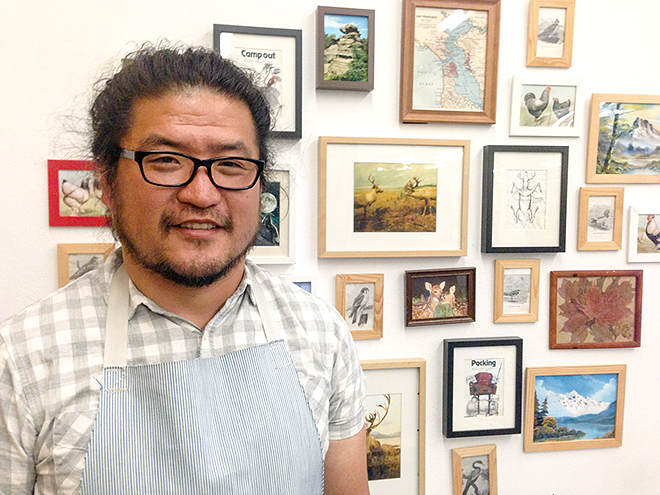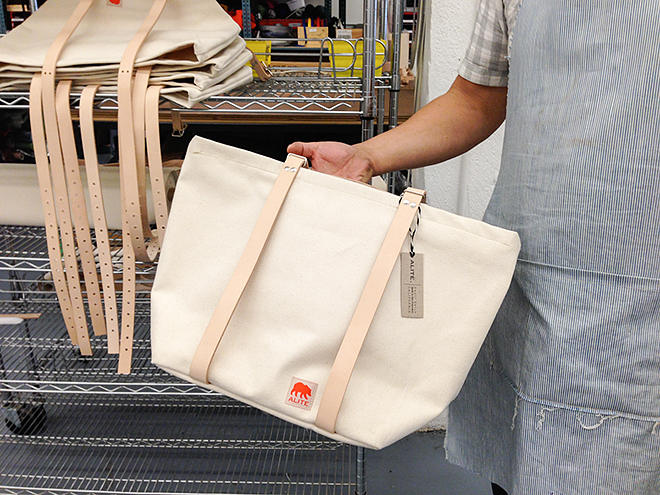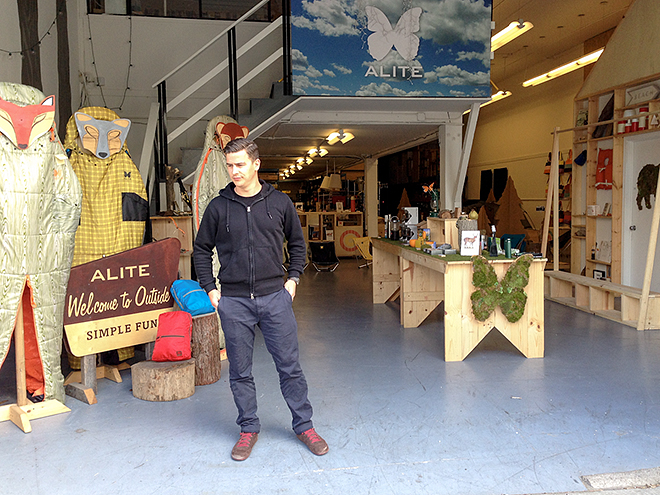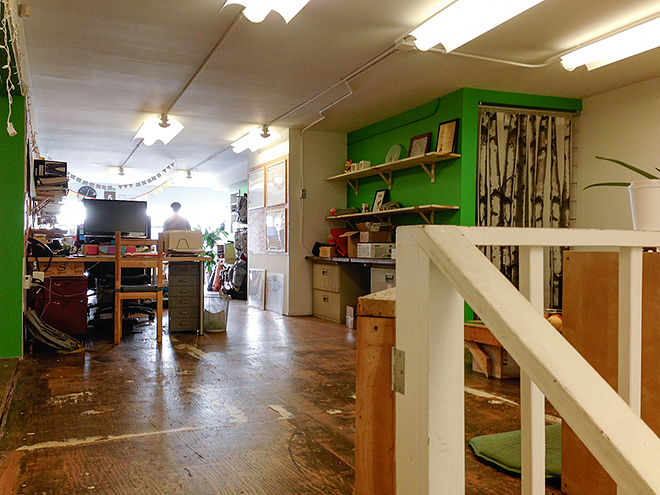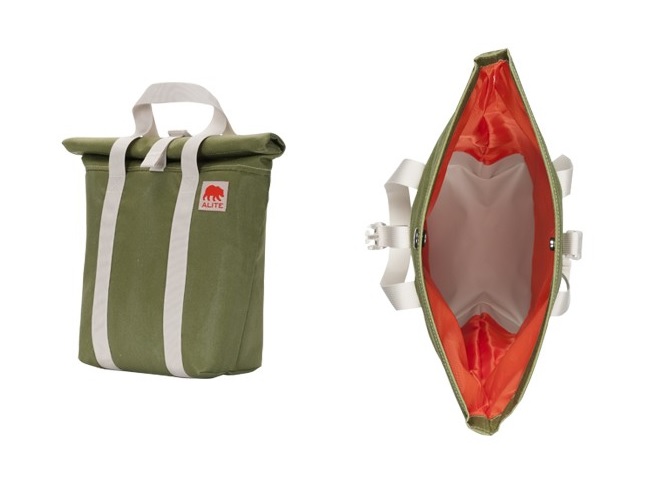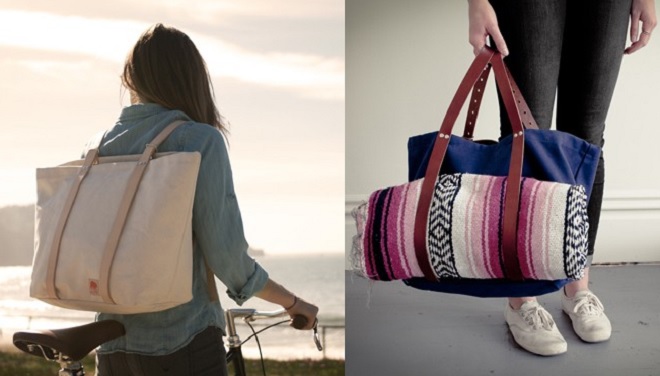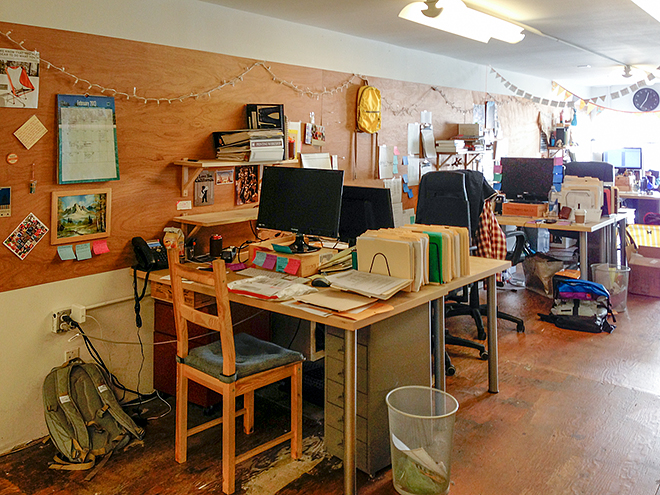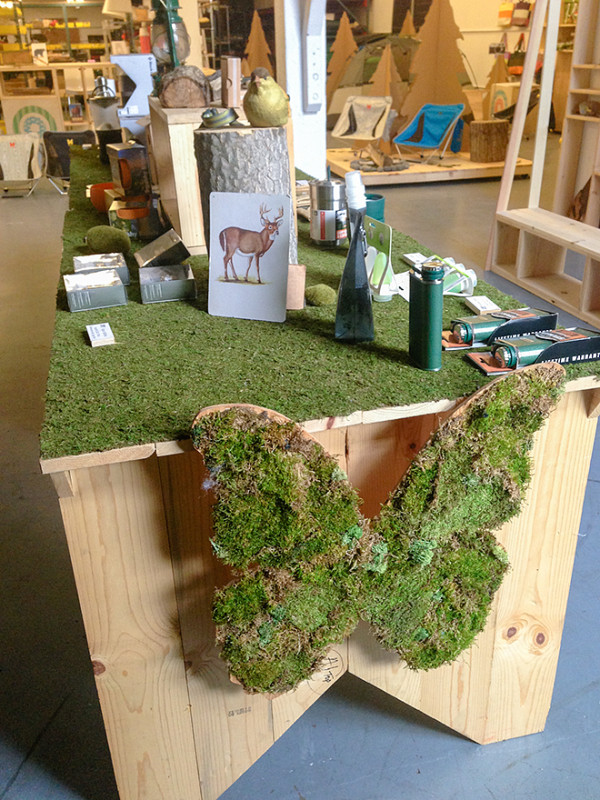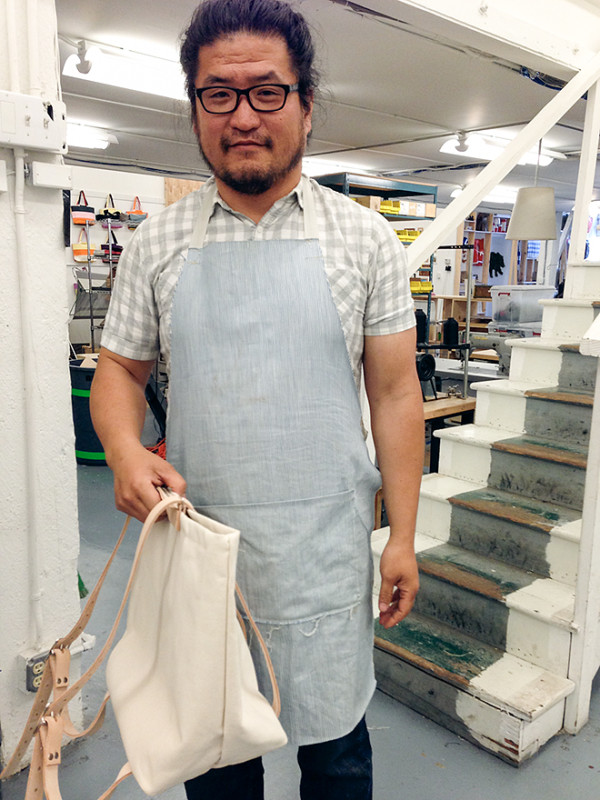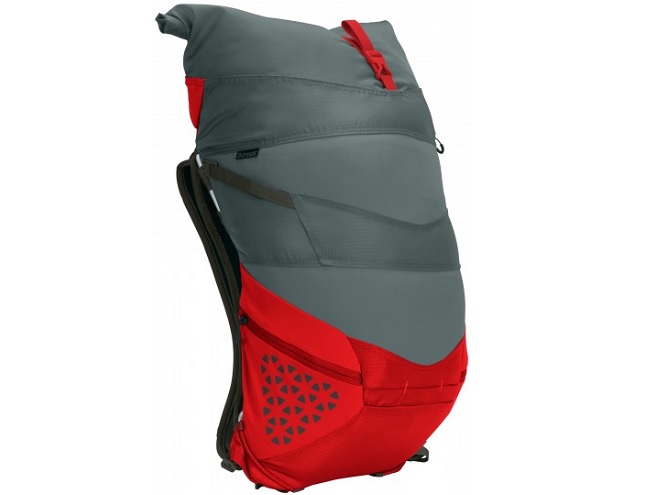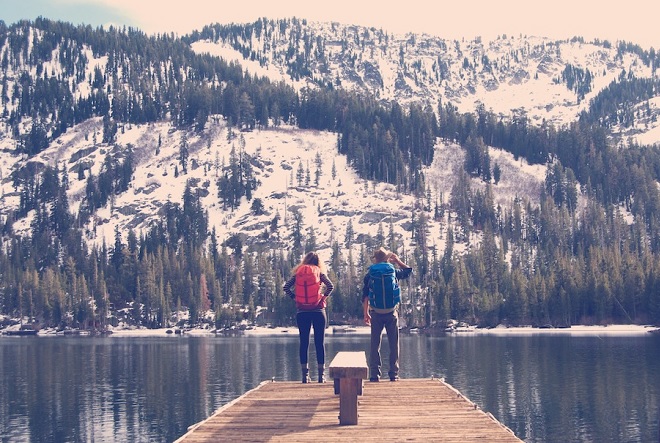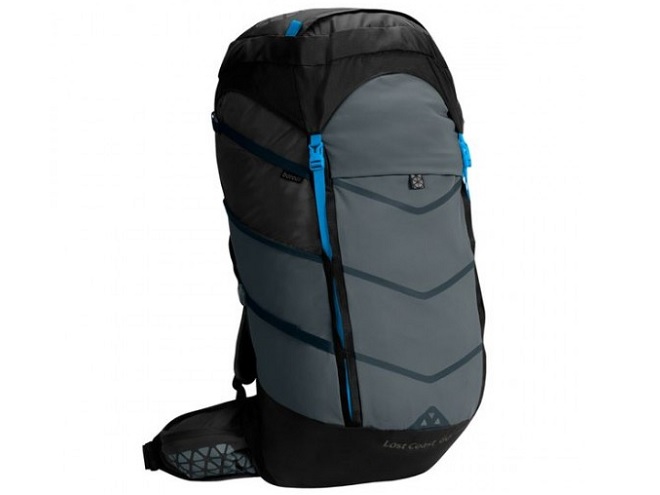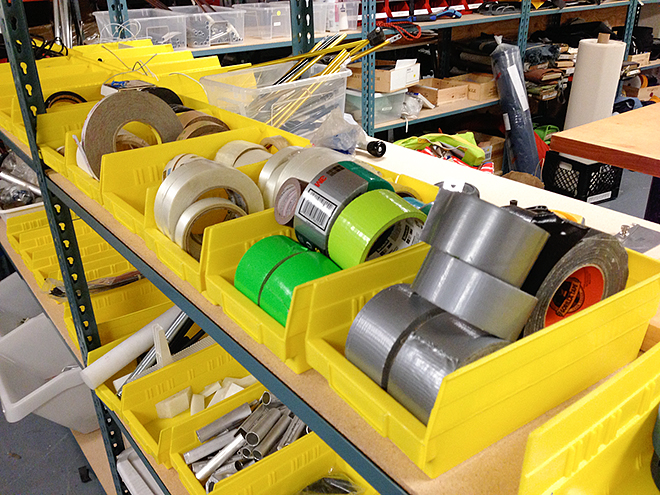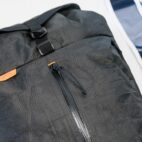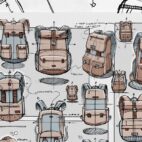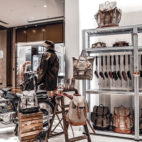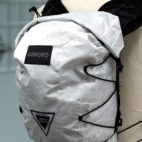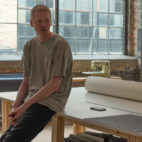Interview with Tae Kim :: Part 1
So we finally got to sit down with Tae Kim, a bit of a legend in the world of carry. A long time Creative Director at The North Face, Tae now runs Boreas and Alite, while consulting on all number of other projects. We recorded the session, and then tried to then cut the interview down to just the highlights, but we gave up.
Instead, we’re posting the whole discussion, in two instalments. If brevity is your thing, maybe just look at the pictures. For the rest of you, grab a drink, settle down, and eavesdrop on a very influential figure in the world of carry…
———–
Picture some strong handshakes, some general small-talk, and then we emerge into the real carry stuff…
Tae: I love soft goods, but they are not easy to do well.
Ando: I completely agree on that fascination with soft goods and it’s an area that’s so hard ‘cause the industrial designers like to fix surfaces, they like rigid things they can work with. And then fashion designers really aren’t great at understanding space and interaction of volumes. So the soft goods area is trying to get your head around this sort of hybrid of soft versus hard forms and how to make them work together. It’s hard, like it’s one of the hardest design areas to be good in.
Tae: “Yeah, sewing in fabrics, it just doesn’t really lie to you. You can’t fake it.”
Tae: I’ve known a lot of hard case designers who try to come into soft goods, but you have to pay your dues. You have to know the fabrics. You can’t make it do a lot of stuff so like, I think Incase struggled through a lot of that at the very beginning because it was started by a bunch of hard goods guys and they were trying to make fabric to things that they couldn’t, and I think they’ve succeeded and I think for them getting into iPhone cases and stuff was really more up their alley.
Ando: Their comfort area.
Tae: Yeah, so you can see how they’re thriving and influencing.
Ando: I think it’s really interesting in that soft goods thing too the way when you start digging there really aren’t that many individuals who’ve been super influential. There tend to be these key guys that have been behind so many of the transitions and step ups in that area.
Tae: Yeah. So when I was growing up in the 80s in Alaska, learning about professions was also really hard. So you mainly looked at magazines, so the outside magazines and the backpack magazines and all the things that you could find, they talked about the individuals like Paul Kramer from Mountain Hardwear. He was just an amazing character. Dana Designs, Dana Gleason was an amazing guy.
Ando: He still is.
Tae: You know a few other individuals like Mike from Osprey is kind of the current, I feel, the most influential designer right now. But it’s such a broad area, outdoor camping gear. So like the guy who designed the MSR Hubba Hubba is just this amazing guy but the Hubba Hubba is probably in the last 20 years probably the most influential tent out there because everything started becoming Hubs. Yeah, it’s really hard for tent designers because there’s only like three full-time tent designer jobs in the world and so it’s the love, the appreciation isn’t quite there and I wish that those guys had more of an audience or some form that we could get that kind of background story a little bit more. So this past OR we launched this Product Underground speaker series. We had like six speakers. Product people. Mike from Osprey was there, Cam from NEMO tents, Kasha Rigby the Pro Telemark skier, Jonathon from BioLite was there and a few other really cool individuals, and they spoke about products and it was such a huge hit. It was like a little underground punk concert, so it was really fun.
Ando: Have you ever seen this book, I think it’s called the Invisible On Everest: Innovation and the Gear Makers? It’s written by Mike Parsons from Karrimor (it’s so British) but looking at the history of outdoor gear and the gear makers and what the stories were, like when they started trying to get their head around light-weighting and expedition-specific gear. It’s really fascinating but it’s like we’re now almost ready to tell the present-day version of that as well. It’s like there is this incredible heritage but now where is it gonna go, who’s gonna take it there and how are we gonna share that knowledge.
Tae: “Yeah. It’s like the old generation has kind of left…”
Tae: Guys like Paul Kramer retired several years ago. So there’s this kind of middle ground group and I’d call them the big – maybe calling them the corporate crew is probably not the best term but they’re the generation that’s in companies that are owned by big corporations.
Ando: Who just have different motivations, they really do.
Tae: And then you’re just seeing a trickling of like Cam from NEMO, myself and a few others who are kind of leading this newer younger generation, the next wave of camping companies, and we really want to promote helping as many people as possible to start new things. Like Jonathan from BioLite Stoves, he’s a friend of mine and we’ve been talking for three years. I’ve been telling him how we started Alite and Boreas and it’s just really great to see. So we really want to foster just – getting people going. It would be a dream come true to put three basic books together that says here’s – if you wanna get into tent design, this is kind of the basics of tent design..
Ando: So right now it’s like a lot of cycling companies have taken over a lot of the innovation recently because you’re probably right, it’s because they’re the small startup companies that have focused on innovation, not just on money and it feels like outdoors is kind of ready for that. How do you feel about the integration of outdoor and work life, because one of the reasons cycling companies are finding ways to innovate is because it’s like you ride to work, you know.
Tae: Yeah, I mean I think for both companies, so Alite is big into camping and then Boreas is more kind of, again, that approachable type of a product. So I call it multisport, so I think not a ton of people are doing multi-day backpacking trips and so versatility is a really good thing. And so for us we really like the fact, like the whole reason for that Bootlegger series was because instead of buying three backpacks, I could buy a really dialed-in suspension and I could just buy packs that worked with that.
Ando: I was talking about that a few years ago, after I got this Patagonia jacket, and Patagonia designers have actually said it, they’ve gone, yeah, you buy this ice climbing jacket and a snowboarding jacket and this jacket and then that and they sit in your wardrobe for eleven and a half months of the year and it’s like this is stupid collecting the set. Or you’ll go overseas for an avalanche course for a week and then go combo a surf trip and then go tack some work on the end and you’re like, what, am I meant to take three totally different getups? Like this is nuts, that’s not adventure travel. So once you start going adventure travel it’s like how do we create those things that can transition with us from this to that?
Tae: This is kind of an interesting place, San Francisco, because you could surf in the morning and then you could be up snowboarding in the mid-afternoon. So it’s all about multisports and then in order to pay for that everyone is working for dot coms, well-paying jobs and stuff…
Ando: But you can see that, you know, if you can see some of the Aether, Mission Workshop, you guys, there’s just these hubs of innovation because of that. The dynamic stuff often happens at the intersection of worlds.
Tae: You’ll find a lot of them do have large company backgrounds but they just could not operate within that.
Ando: In that machine.
Tae: “And then I love it when people want to hijack design and so that’s when the designs get really, really good.”
Tae: So if you can’t find something you want, you’ve already identified the need but you can’t find it so that’s always the right opportunity to start something.
Ando: Yeah, I totally agree. I think Kickstarter is going to be – it’s already really powerful. I think the next couple of years, that’s a pretty exciting platform for that.
Tae: Especially people who know how to commercialize…
Ando: Tell the story.
Tae: Yeah, tell the story and commercialize it ‘cause there’s been a bunch of wrecks on Kickstarter where they raise a ton of money but it was all computer drawings so they couldn’t actually make it come through. So I think there was that watch company that raised a million dollars. I heard that they had to give all the money back ‘cause Apple wasn’t gonna license their technology to them. And then I think there’s rumors that Apple was gonna come out with their own model. So, yeah, for us we could commercialize it, we could come out with good products but since we are all bootstrapped and stuff we do – just getting like $20,000-$40,000 just to give it that head start means so much to us.
Ando: Yeah, totally. Where are you finding your connection with your customers? I guess most of your business is still kind of selling to retailers who then sell to customers. How are you finding the connection back to watch how customers are using your product and doing that sort of thing?
Tae: I think there’s two parts. When we first started Boreas it started because our friend Chris has this eco-tourism company that saves sea turtles on the East Coast, so he was always buying outdoor gear and was trying to get a deal and he was finding that he was using mountain products in Mexico. So that’s kind of initially how it all started because we were like, hey, people travel so differently; like eco-tourism and what he does in Mexico it’s just so different than a mountain product and all outdoor gear seems like it’s all made in an outdoor – on the mountains. So we just thought that there was an interesting space where adventure travel – a lot of friends of ours go to South East Asia to climb yet they’re saying sometimes they take a little break and stay at a beach resort. They’ll go to Bangkok, stay in a nice hotel. Some of them will work at farms, and so it’s this amazing new way of traveling and we just thought if it works really well for their lives it’ll be something like transient products out there.
So we feel like there’s this niche and then customers are all of our friends and a lot of it is inspired by just interacting – like in San Francisco, it just seems like this really ahead hub, it’s just different ways of traveling, different ways of outdoor experience and so a lot of people have never gone camping again. So it’s just been an interesting thing, being centrally located here is just an amazing opportunity.
I think both of us and all of them come from an expertise level that may be a little too much for relating to our customers. So we really have to kind of be able to investigate our customers, and we’re really good at focusing on real life people – our friends who live this type of lifestyle. I went to Stanford and that whole ideal, that experience and researching I was taught at Stanford. So a lot of it is based on customers’ needs, people’s needs. So it’s just really nice that the way we design is kind of that focus.
Ando: And in areas that you feel you’ve got calibrated standards ‘cause it’s close to what you want as well so you’re not having to try and guess too much.
Tae: I think for both companies that we’re really clear on who the customers are but I know that I grew up in Alaska and had a different slant on outdoors. I just wanted to be a park ranger so there’s this mix of like Joel who’s an ultra-marathon runner, and then we have another partner here who is a Russian kayaker, Lyosha, and so it’s just a real interesting thing but we all come together. We’re very customer-based and the ability to have empathy for that customer saying, okay, the products aren’t addressing what they need are our key things. So like Mission Workshop, when they first started I was like why would the Chrome guys start another bag company and then I went out with them and they were so keyed in on who their customers are and it was very refreshing to hear that, and Aether is the same way.
Ando: I agree, I actually think business is usually a collection of customers that you’re trying to service and if you think of it that way you often end up with more relevant, more targeted stuff and if those customers are kind of like you and your friends that’s gonna be even better. You’re going to get it.
Tae: Yeah, and then both companies we have success in wholesale but our main thing is to make sure that we have an even business model for direct and wholesale channels. The wholesale channels are a little – I think business is so fast online and I think the traditional outdoor companies underutilize the Internet for education and customer feedback and stuff.
Ando: So interestingly, in that space with some of those emerging brands that are just slightly up from the basic spot price points but not into luxury craziness, I was saying to Joel it’s Rapha, Outlier, Aether, I think they’re all around 80%+ online direct Web store to customers. It’s sort of letting everyone bypass this loop and just get direct feedback. You watch the interactions, you’re dealing with all the customer inquiries personally, understanding where confusion comes. Even just that is – and it’s funding growth, you know, it’s – you’re getting a bit more money which lets you put that back into growth, into projects.
Tae: Yes, the Outlier guys are really good close friends of ours so we’ve been hanging out with them for a couple of years now. So they were interesting. I think we could learn from both sides and have learned from both sides, and so we’ve helped on how the business model is so that they could wholesale it and have a little bit bigger growth but they’re phenomenal. I mean the percentage growths are just staggering.
Ando: It’s exciting in that way, isn’t it, that good ideas are able to spread faster.
Tae: “I think for a lot of the bigger companies, their hands are tied to the wholesale side.”
Tae: And I think just the wholesale side, they could just re-interact with a lot of wholesale channels and stuff. They’re great, but sometimes trends bypass them so fast that they can’t react to it. So our direct channels we’re investing heavily into so that it will grow into a better connection of wholesalers.
Ando: Excellent, that makes a lot of sense.
Tae: And we set up the shop, and we’re starting to make Made in San Francisco products and stuff.
Ando: Yeah, right, just as an alternative sort of thing or a different product line or what will it be?
Tae: We call it small batches, it allows us to kind of – when we – when a product comes out I have to stop thinking about it for a year and a half so whenever it does get launched I always have to kind of go, oh yeah I forgot, I designed that product a year and a half ago, ‘cause we’ve moved on. So it’s just really interesting to see, but the direct side is immediate and so we’re doing a run of bags for Alite right now and it’s a bag that Outlier and I worked on a while back and so we’re doing a small batch production run of it.
Ando: Yeah, that’s exciting.
Tae: Yeah, it’s a tote backpack and it’s called The Bike To The Beach bag. It’s all made here, it’s been really fun. We could just do 20-50 unit runs, get it out there and we’ve learned so much from that.
Ando: So do you think – like one of the things that a lot of the contributors would love is a Boreas bag but made in materials where they can run it in the office and feel better about it rather than sort of nylons and stuff. Do you think there’s a chance that we might, like the Advanced Projects stuff of Mission Workshop, we might see that higher end – maybe it’s made locally so you’ve got faster turnaround…
Tae: Yeah, definitely.
Ando: …fast development cycles, fabrics that work in the office space and then take it outdoors sort of thing.
Tae: Yeah, definitely. Some of the Japanese stuff that we’re working on is made to be that way, so a little bit more, definitely a little bit more textured items, and just a little heavier, more durable for the urban environment.
Ando: Yeah.
Tae: And little touches of leather and things like that, so a little bit more craftsmanship, so…
Ando: Yeah, right.
Tae: Yeah, so definitely in that direction.
Ando: Yeah, excellent.
Tae: When we get that wax canvas prototype in, we’ll send you guys some.
Ando: Yeah, definitely. That sounds great. So there’s this sort of – you launched Boreas and it was more sort of – it was almost like starting with pieces that are a bit more traditionally focused segments and now it’s like, okay, now it’s sort of got that base we can start to build out more into the adventure travel, more into the kind of urban transitional pieces. Is that sort of…
Tae: Yeah, it’s interesting because we kind of self-fund everything so there’s a certain strict business model that we follow with new companies. So this group will eventually – there’s four or five partners who helped start it. Some of them work here, some of them don’t. So the whole idea is like in four or five years, there should be about six companies that are doing some really interesting stuff. So there’ll be a new company launching next month.
Ando: Oh, wow.
Tae: It’s called Tiny Tools and it’ll launch – we’ll give you guys some more information…
Ando: Yeah, great.
Tae: …but we have ideas for a shoe company and some clothing, some really cool clothing stuff and there’s a certain business model that we follow and so it has to go through this interesting wholesale traditional pathway first. Award-winning products that give it the next step in the business side before we can hire a couple of people.
Ando: Yeah, right.
Tae: “Usually when we launch a company no one is hired for the company.”
Tae: So we launch it; if it’s successful then we’ll hire a couple of people. And then if we make it past a million dollars in sales then we know it’s gonna survive.
Ando: Yeah, so you start putting in the resources for it. So how much is it kind of shared ownership, is it sort of similar across all of the businesses, is it the same team, or does it sort of mix and match?
Tae: No, I’m the primary owner for all the companies and then we find friends who want to take leadership roles in those.
Ando: So each company has a leader other than you and then you work across them and support sort of thing.
Tae: Then if Joel has an idea and he wants to start a company in a couple of years, we want to help champion that for him as well. So it’s just friends starting businesses together.
Ando: That’s exciting, yeah.
Tae: It shows when we’re at OR and stuff because Outlier are good friends of ours, NEMO and BioLite and we all share information about who’s doing what and what resources we could share, so it’s just amazing.
Ando: That feels like a shift that used to be there in the companies that are now mega and changed to corporate and when you see that dynamism, people seem to be more open with info.
Tae: Yeah.
Ando: It’s like shit, man, I’m not worried about what you do because it’s different to what I do so I can share ideas with you, you can share ideas with me and we’re not playing in exactly the same space in the industry.
Tae: Yeah, exactly and I think the designers want the community. The designer owners want that community because they’ve done it in such isolation and it’s the big corporations that hinder that communication because you’re not really allowed into the tradeshow booths, to the designer and so we really wanted to break that down. So at Boreas, Alite, anyone could come and check anything out. We’ll explain everything to them and so – and we’re not worried because I feel like there’s this respect level that is on the rise and then if people – people will copy stuff if they want to so our job is to – it’s never been our model to hone in on one thing and stick to it. It’s just we have so many ideas I think, it’s just you know – you could start so many companies from the ideas that we drop. So we really have a fun time working on the stuff and challenging.
Ando: So is that – when there’s a different head for each business, are they going in different directions to what you envisage when you sort of started to play in the…
Tae: It morphs, so I wouldn’t say we had super strong visions of what Alite or Boreas was going to be but you have to be reactive to different situations and we’re learning so much from it and it’s quite amazing.
Ando: There is a Barry Diller quote I love that is “Put one dumb foot in front of the other and course-correct as you go.” Don’t expect to set a big vision that you’re hunting for seven years…
Tae: Yeah, that’s never the right thing.
Ando: Yeah.
Tae: Everyone thinks because both Alite and Boreas are now successful, people are like, you must have this amazing vision. It’s like no, we were just kind of, we know what’s out there, we didn’t want to do that type of stuff. So we knew there’s these opportunities, these holes, so we just tried it and we wanted to see how it goes. I think most people hold themselves back. They think that there’s a magic formula.
Ando: So that means also that you’re not taking that approach you see in some artists where it’s like I don’t want to see other stuff out there, I want to kind of have my pure vision and realize it. It’s more like you guys are actively trying to understand what’s in the market, what people are doing and then finding a place that it’s like this is a gap, this is what people need.
Tae: Yeah, we try not to copy people’s stuff or be too influenced by it. So there’s a good example of like in San Francisco there’s a lot of little brands starting bag manufacturing. They’ll walk an old retro bag into a factory and make it out of different material. So one company, a friend of mine did that and I said – and he was so happy with it, he was so happy with this Jansport backpack leather thing and I was like that’s great and all but like you know that’s a Jansport backpack.
Ando: Yeah.
Tae: And he goes yeah but it’s so old, like it’s retro. I was like no, I know Skip and he is the guy who designed it, I’m friends with him. They’re still making others and so it shows that you don’t really know about the history of this bag. It’s cool and all but that is Skip’s bag. So if you knew Skip you would – he is such a great guy you would know not to mess with that stuff. So then he fully understood that and went back and made enough changes where he felt like it was different.
Ando: So maybe we do need to tell the stories of all of those iconic bags and who designed it and understand it and get that story out, do you think, like help people understand that this isn’t a faceless library that you should just draw from and reproduce sort of thing.
Tae: “Yeah, ‘cause what’s the difference between an American brand copying – ripping off someone versus like a Chinese brand ripping off someone? There’s no difference, right?”
Tae: So having some respect for each other. Now there are certain times where a designer, many designers will have the same idea, many, many times but you got to do the history work and just study it enough that you know that it comes from a certain place. And when innovation happens it is so great, so beautiful to see. So I mean just thinking Mission Workshop and Chrome, just looking at the history of it. I remember when they first were doing kind of the 1950s, ‘60s sparkly fabric, right, and then that – and then just getting into DJ bags and stuff, and then they came out with the messenger bag and that was just amazing stuff and just beautiful pattern making and I just – like that’s a symbol of them taking it up a notch. And then these are this next kind of notch. So I think if you’re gonna be in this for the long haul you got to have that understanding and education for that.
Ando: I think too it’s a different focus to a lot of the larger established guys are trying to almost release seasonal product now and kind of getting caught in that apparel trap because a lot of them have apparel lines, that sort of thing, and it’s like instead it’s, it almost feels like you’re thinking as platforms, like what’s the next platform and it’s like this will be a product and we might fill out around but that’s something that we then build into the global library of carry and it’s there. People draw inspiration from it.
Tae: I think this is a very common thing but we again are kind of gear heads at heart as well so a lot of it also – I think maybe our success is that we have a love for the products and design on top of seeing the business opportunity. So I think within that we still have this love for bags and it shows and there’s different levels. So if you look at both Alite and Boreas and what we’re up to, it’s just a wide platform of stuff and this is really amazing just to be working in this industry and this type of stuff.
Ando: So Alite is an interesting one ‘cause it’s almost like rather than the mission being product related it really is like celebrating outdoors. So you can see Poler is there and I was saying Quiksilver is about to kind of – they’ve just released an outdoor line that’s about fun outdoor stuff and it’s kind of growing, it’s more and more stuff. What brands do you see in the Alite ecosphere, are there crew that aren’t even making outdoor gear that you sort of think of as working in the same sphere of celebrate outdoors, make them accessible, make them fun for novices and…
Tae: I really love – I really admire Freemans, sporting goods, right.
Ando: Yeah, right.
Tae: So I love the restaurant in New York, I love the barber shop, I love their sporting club feel. So that’s been going on for a very long time but it’s just hitting now the mass, right.
So I – but I still really love like Fjällräven and Best Made out of New York, the axe makers and stuff, they’re doing some really nice stuff.
And then there’s some smaller brands, like I love Peg and Awl, a small group out of Pennsylvania and their – the craftsmanship side of it, it was just really amazing and it’s just so inspiring on my end that we’re going to make about six products here in America. Our tiers are so simply designed it’s very easy to make it all in America.
Ando: Yeah.
Tae: So that’s the inspiring side, seeing not only older brands like Fjällräven kind of getting the rebirth and you know when Andrea was the – owned the US distribution, we, Outlier guys, Andrea, we all had the same PR firms and stuff. And it was just amazing to hang out. At OR we’d go to I think Shiloh’s, there’s a hotel right there, there’s a restaurant there and there’s all these parties going on. We’d pick one night of the week to all meet up over that PR firm and all of her clients and it wasn’t like we were trying to make a PR event but it’s just that it’s all these like-minded people who are starting businesses and it was just amazing to walk around this restaurant and see Outlier guys, BioLite, Fjällräven, like it was just – it was amazing but you have the older kind of more heritage brands and then you have all these smaller brands that are just pushing it. And then I’ve done some work for Eddie Bauer and Jeremy Jones and all these places and I do a healthy amount of contract work with people but it’s – because friends all worked there but I remember getting the historical tour of Eddie Bauer. It was amazing, they were the first patent owners of quilted down jackets, right, and so – because like…
Ando: I mean that technology alone has opened up the outdoors in an incredible way, hasn’t it?
Tae: Uniqlo that’s their whole bread and butter, but the history of the outdoors is just so amazing and we’re seeing almost a full circle and World War I and II these outfitters that were outfitting people to Canada and then to Alaska, the government seized them and made them make –
Ando: Ramps them up, make a million units or whatever.
Tae: Yeah, they made bomber jackets for the pilots and sleeping bags and stuff, so that was like the initial birth and then 60s, 70s Berkeley saw the birth of Patagonia, Black Diamond, North Face, and those guys were all super partying, drug-taking climbers, outdoor people, you should hear the stories. I’m friends with a lot of them and they’re all older and have kids now but man they just had this amazing explosion.
Ando: It’s funny ‘cause a lot of the Carryology office come from surf industry background and that was the same thing. Like ‘69, ‘70 into ‘75 and 80s even, it was just this, it was like the cluster bomb that’s happening right now as well, where as you said there’s sort of that last generation has almost retired and it’s time for the new gen, except maybe now the guys doing it are just that bit older so there’s a bit less of the crazy irreverence…
Tae: No, I’m going to kick it up on that one, you didn’t go out with me last time! Well I think this generation is the multisport; all of my friends surf, have skateboards, snowboards, ski, it’s like – it’s that era now, it’s that multisport era, so all these brands should be able to embrace many people through many different scenarios.
So, and that’s – world travel is that way, outdoors is that way. Not a lot of people talk about this but those tradeshows are just so conservative and they’re the reasons why biking isn’t as integrated into the outdoors. Outdoor people are the same reason why biking isn’t integrated, you know. I have hopes that I could start a, be a part of a tradeshow that’s this cooler new way of thinking of outdoor.
Ando: Yeah, have you seen the new mega trade show that’s going to be happening in August, so they’ve just announced it I think a week ago that Capsule and Agenda and PROJECT they’re all coming together in August. So it’s going to be just a mega show, I wonder if that’s kind of, that’s not actually going to solve the problem of bringing it back to small communities that can actually catalyze change and work together.
Tae: I thought like, Above the Treeline was a nice initial step. Andrea who loved Fjällräven is behind Above the Treeline and she put a lot of the cool kind of brands together. But you know the weird thing is this new generation of outdoor has a little bit of kind of hipster, kind of like little bit too cool for school thing going on. I’m not sure if I’m as down with that as – because both companies’ philosophy isn’t really about isolating a group or hyping up a group. It’s more about embracing everyone.
Ando: Yeah, totally.
Tae: So, I think that’s kind of how the outdoor history was in the 70s when people were like, I could just go multiday backpacking in Tahoe and I could do it this way and so I’m always a little weirded out by just the being too cool.
Ando: Yeah, totally. They’re all using Herschel bags so they obviously, you know…
Tae: But Herschel is actually an interesting one because I’ve been trying to wrap my head around how in two, three years they’ve come –
Ando: They are everywhere.
Tae: “They are everywhere. So then I’ve asked a few buyers and they said, you know, it’s a Jansport backpack but they do such a great job on color.”
Ando: Yeah.
Tae: Herschel just has this really great color story.
Ando: I think that’s really good. I was just saying to Joel before, I almost feel like me trying to look at a crystal ball of future, I kind of feel like the explosion around merino wool in the outdoor industry over the last year hopefully is that shift where outdoors, you know, connecting with nature, getting back to the whole thing and then we’re all using saturated primary color nylons and plastics flat out and that doesn’t sit with me. Like, you know, can you make products that feel like the outdoors bought onto your back, an ideal body, and I wonder, I hope that the next few years we’ll actually see that kind of settling of outdoor vibe with materials, with constructions that work and that doesn’t mean heavy cotton canvas in 20 oz. this and that. There can be more creative approaches to it but just giving you the feel of outdoors as you then sort of move back into urban life or whatever, it still feels great but protects your contents from the rain, does this, does that, whatever. I hope we start to see that.
Tae: Yeah, I think materials, it’s really hard to innovate in materials…
Ando: Yeah.
Tae: …because the material companies have a hold on it, so as soon as – like I think –
Ando: When Herschel did it, like they got these colors, you can almost see how open the weave is, you’re seeing all the backing straight through. It’s like they obviously didn’t find the quality fabric suppliers.
Tae: So I think, you know, the Outlier guys are probably one of the best people I’ve ever met who love material design. I’ve known at North Face where there are people who are paid to be experts on materials and –
Ando: And they’re not as passionate as the Outlier guys almost.
Tae: “Abe and Tyler out-passion almost all others…”
Ando: And they’ve worked a lot with Schoeller haven’t they, and a few others and –
Tae: Abe knows so much about materials and it’s because he’s using it, he’s at the factory seeing it and a lot of outdoor designers design everything on the computer.
Ando: It’s true. Just this morning I was talking about you shape your tools and then your tools shape you and apparently when computer-aided design first came out you can actually pinpoint a lot of buildings to that kind of early 80s era ‘cause all of a sudden door handles are right next to walls and you can’t get your hand in there. They got this new tool and they didn’t understand and then they’d lost scale. When they’re on paper they had scale, they had it and then they lost it on the screen and it took a while to learn what that means and it feels like computers have done that. It solved all those problems so crew dived into it but then they didn’t realize what they were missing out with these other things of kind of putting it together by hand and understanding the fit.
Tae: Yeah, I used to be a car designer before then and we had the same thing and the era that I was working there, they wanted to make everything from – I was working with clay modeling studios and they wanted to not use any people but they wanted to just mill out like a gigantic mill – like a full size car into the computer and it was a disaster. After they made all these things and invested so much money they looked at the car and were like, wow, it doesn’t seem warm. It seems very angular, and so even though they designed curves and stuff it was the fact that like even on a straight line, a human carving the clay gave it this slight curve to it that made it really warm and I Isuzu modeled a car around that era and that was the first fully 3D designed car and I don’t think it did really well. It looked very like – I think Cadillac is probably the group that uses the most kind of very almost three-dimensional, very rigid style lines and it was kind of in that direction but I think Cadillac has kind of settled itself down a little bit more.
Ando: So how do you encourage yourself and your designers across the various businesses to do – is it sketching paper, is it cut and sew, is it Illustrator outlines, is it a combo of everything and they’re kind of encouraged to move across them?
Tae: It’s pretty much everything, but we start out with the customer and we’ll figure out what problems they are going through and then we use everything within our arsenal to make functional items and then we operate – a lot of companies, like North Face in particular, they’ve really radically streamlined how many iterations they do at the factory and so for us we do tons of iterations. We’ll make like 50 prototypes of something before the final one is done.
Ando: Yeah, that’s excellent.
Tae: And then we use it, we try it out and yeah some, in my history some designers have never wanted to put on their product and we’re so lucky ‘cause these are manageable products and so you got to try it on.
Ando: So does that mean just here you’ve got the expertise to basically lock away the pattern before the bag sort of goes off or…
Tae: Yeah, so for us I think I’d say we have probably one of the best design teams’ process in the outdoor world. We can pretty much make anything. And we are young and nimble enough that, you know, that we’ve integrated 3D modeling into our thing, 3D printing, 3D metal work, pattern making, sewing. A lot of tools.
———
Stay tuned for Part 2 which concludes the interview with Tae.





 Carry Awards
Carry Awards Insights
Insights Liking
Liking Projects
Projects Interviews
Interviews
